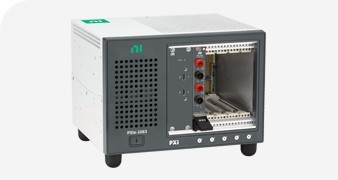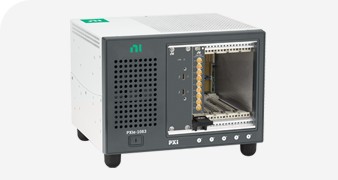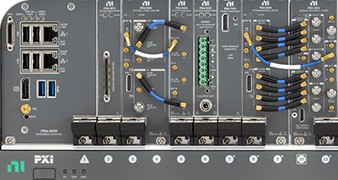Device Testing with Digital Pattern Instruments Course Overview
Learn to effectively use NI oscilloscopes to select the right instrument and probes for your measurement needs. Set up your oscilloscope device and perform both interactive and programmatic measurements of your DUT.
Available formats
Virtual training not available for this course
Classroom training not available for this course
Private training not available for this course
Course Objectives
-
Create and edit all elements required to burst a digital pattern to your DUT, including pin maps, level sheets, timing sheets, and pattern files
-
Test DUT modes of operation with SPI commands
-
Validate DUT communication via register readback testing
-
Validate DUT timing by interfacing with external test equipment
-
Validate DUT pin connections via continuity and leakage testing
-
Utilize opcodes to establish flow control within patterns
-
Use source and capture waveforms to simplify pattern structure and store data
-
Synchronize your digital pattern instrument with other instruments in your systems
-
Use History RAM reports, Shmoo plots, and digital scope to perform debugging activities
-
Calibrate your instruments and correct for any cable skew
Course Details
Duration
-
On-Demand: 5 hours
Audience
-
Test Engineers performing semiconductor device characterization and production test.
Prerequisites
-
Working knowledge of LabVIEW or .NET C#
NI Products Used
-
NI Digital Pattern Editor 2023 Q4, or later
-
NI-Digital Pattern Driver 2023 Q4, or later
-
LabVIEW 2024 Q1, or later
-
NI PXIe Digital Pattern Instruments
Training Materials
-
On-demand training includes digital course materials delivered through the NI Learning Center, available for the access duration of your subscription
Cost in Credits
-
Included with software subscription and enterprise agreements, or 5 Education Services Credits, or 2 Training Credits
Device Testing with Digital Pattern Instruments Course Outline
| Lesson | Overview | Topics |
|---|---|---|
Creating and Bursting Your First Pattern | Configuring a pin map, level sheet, timing sheet, and pattern file, bursting a digital pattern to the device under test (DUT). |
|
Creating Pin Maps | Creating pin maps in Digital Pattern Editor to define DUT connection sites. |
|
Creating Specifications Sheets | Storing values from the data sheet of DUT in specifications sheet variables. |
|
Creating Pin Levels Sheets | Create pin levels sheets to define the supply voltages, termination, and logic levels for the DUT. |
|
Creating Timing Sheets | Creating timing sheets to define the timing characteristics of the interface with the DUT. |
|
Creating Pattern Files | Create pattern files to communicate with and test the DUT. |
|
Programming Digital Patterns | Programmatically controlling Digital Pattern Instruments using NI-Digital Pattern API. |
|
Testing DUT Modes of Operation | Configuring the DUT with Serial Peripheral Interface (SPI) commands to test its modes of operations. |
|
Performing Register Readback Tests | Performing a register readback test to validate the communication capabilities of the DUT. |
|
Validating DUT Timing | Interfacing with external test equipment to validate the DUT timing. |
|
Performing Continuity and Leakage Testing | Performing continuity and leakage tests to validate DUT pin connections. |
|
Increasing Pattern Robustness with Flow Control
| Increasing the robustness of a pattern by using opcodes to establish flow control. |
|
Using Source Waveforms
|
Using serial and parallel source waveforms to simplify a pattern structure with variable data.
|
|
Using Capture Waveforms
| Using capture waveforms to store received data for validation and post-processing. |
|
Reviewing Test Results with History RAM Report |
Using the result of the History RAM report to debug pattern or device under test (DUT). |
|
Viewing Signals with Digital Scope
| Using digital scope to view the actual voltage levels on the pins of Digital Pattern Instrument (PXIe-657x).
|
|
Using Shmoo Plots to Visualize Parameter Relationships
| Use Shmoo plots to iterate over pattern parameters and view results.
|
|
Synchronizing with Other Instruments | Implementing synchronization strategies such as sharing triggers or using NI-TClk to coordinate tasks with other instruments.
|
|
Wiring and Calibration |
Compensating for cable skew and voltage offsets and exploring device calibration requirements. |
|
Using Opcodes for Scan Testing | Using the scan opcode to divide a vector into one or more scan cycles. |
|
Continue Your Learning Path
Taking Measurements with NI Digital Multimeters
Learn to effectively use NI Digital Multimeters (NI-DMM) to recognize and interpret key specifications, helping you choose the right instrument and probes for your measurement needs.
Taking Measurements using Oscilloscopes
At the end of this course, the user should be able to select an appropriate NI oscilloscope and probes for their measurement needs. They should then be able to set up their oscilloscope device and perform both interactive and programmatic measurements of their DUT.
SMU and Power Supply Set-up, Control, and Optimization
The SMU and Power Supply Setup, Control, and Optimization course enables Test and Validation Engineers to source and measure voltage and current to meet their test needs.
Upgrade to Membership
If you are planning to take three or more NI instructor-led courses within one year, a Training Membership provides cost-effective, unlimited access to all NI public classroom and public virtual courses, along with unlimited certification vouchers.


